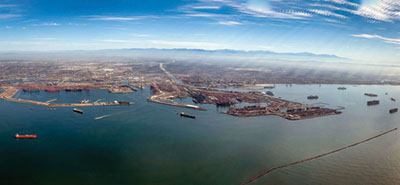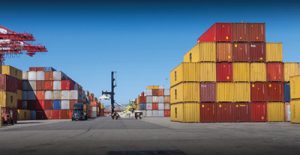
The Port of Long Beach has revealed that it’s partnering with a U.S. technology firm to create a cargo data tool dubbed the “Supply Chain Information Highway,” with a soft launch planned for February.
The platform, which is being developed by St. Louis-based UNCOMN, is designed to help shippers, ocean carriers, trucking companies and others in the supply chain securely connect to track cargo across all modes of transportation.
“Shippers have two basic questions: Where’s my cargo? How do I get more visibility?” Port of Long Beach Executive Director Mario Cordero said. “We’re developing a system of systems that complements existing data-tracking platforms by giving supply chain participants real-time updates at each transfer point in the intermodal network.”
The port has said that the program will offer supply-chain members “a seamless connection to optimize different public and proprietary systems and help them solve their unique logistics problems.”
“Think of all the individual platforms in the marketplace today as cars,” Deputy Executive Director Noel Hacegaba said. “The Supply Chain Information Highway is the freeway that enables all of these cars and their data to travel on one common system.”
The data tool is the latest in a series of actions the port has announced in recent months to accelerate the flow of cargo, many in direct response to the pandemic-induced backlog that has slowed cargo moving through the San Pedro Bay complex and Southern California supply chain.
Long Beach is investing $400,000 in the program, and plans to offer the tracking tool to maritime goods movement stakeholders at no cost.
Long-Term Solutions
As North America’s second-busiest seaport, after the Port of Los Angeles, the Long Beach gateway has focused on efficiency measures to enhance the flow of cargo. The port’s major capital improvement projects were underway years before the pandemic outbreak. In October 2020, the port completed the Gerald Desmond Bridge Replacement Project, a 10-year, $1.5 billion construction project to build a new, higher and wider bridge to accommodate 21st century commuter traffic and vessels. Last August, the port celebrated completion of the $1.5 billion Long Beach Container Terminal at Middle Harbor, one of the world’s most advanced and greenest container terminals.
The POLB has also completed numerous rail enhancements and is moving forward with more than $1 billion in improvements to its on-dock rail network, the centerpiece of which is the Pier B On-Dock Rail Support Facility. When fully operational, it will allow more containers to ride the rails to their destinations, maximizing on-dock rail capacity and reducing truck traffic and related emissions.
Last June, the port announced a partnership with the Utah Inland Port Authority to accelerate the movement of cargo destined for the nation’s intermountain consumer markets in Utah, Nevada, New Mexico and Arizona.
“Pushing cargo out of our terminals on trains maximizes our on-dock rail utilization and frees up more trucks to support the Southern California market,” Hacegaba explained. “And by connecting the Port of Long Beach with the Utah Inland Port Authority, we are literally building the longest port in the nation.”

Pandemic Pressures
As cargo volumes dropped precipitously in early 2020, the port’s Business Recovery Task Force was taking action, with its early initiatives including launching a new web page to keep customers and the supply chain informed. The site posted real-time operational data on gate hours, ships in port, and notice of canceled sailings up to three weeks in advance.
By mid-summer, the port had distributed hundreds of thousands of face coverings and personal protective equipment to longshore workers, truck drivers, terminal operators, railroad workers and neighboring restaurants. The port also opened a center on its property to make COVID-19 testing more accessible to dockworkers, truckers, port staff and City of Long Beach employees.
In July 2020, cargo volumes went from sluggish to supercharged. Unprecedented consumer demand, skyrocketing online orders and retailers racing to keep pace—all prompted by the pandemic—unleashed a cargo tsunami.
In October 2020, the POLB partnered with Pacific Terminal Service Co. to open the Short Term Overflow Resource (STOR) yard at Pier S. What started as a 17-acre near-dock yard for staging loaded import and outbound empty containers has since grown to about 65 acres. Other such yards have also opened, bringing the total of short-term overflow yard space to about 100 acres.
In December 2020, the port worked with terminal operators to prioritize dual transactions to streamline cargo moves by encouraging trucks to deliver outbound containers and pick up imports in the same run. The port also debuted its Weekly Advance Volume Estimate (WAVE), an online dashboard to increase visibility needed for the supply chain to navigate the cargo crush. The year ended with an all-time high of more than 8.1 million twenty-foot equivalent units (TEUs) moving through the Port of Long Beach.
Container volumes continued to mount in 2021, breaking records month after month. Last February, the port partnered with the Long Beach Department of Health and Human Services to offer COVID-19 vaccinations to dockworkers at the port complex. Then in May, the port and health department teamed up with the National Guard, the Port of Los Angeles and the International Seafarers Center to provide vaccinations to visiting vessel crews.
Then in September, with ships at anchor piling up in and around the San Pedro Bay harbor, both the Long Beach and LA ports rolled out initiatives to reduce the logjam. Long Beach teamed with Total Terminals International to launch a 24-hour operation at its Pier T container terminal, and collaborated with other terminals to expand their hours of operation.
The POLB also unveiled its “Truck Alert” text message notification system offering updates and alerts about traffic conditions within the port complex.
On Oct. 13, Cordero was in Washington, D.C., with Port of LA Executive Director Gene Seroka and International Longshore and Warehouse Union President Willie Adams to meet with President Joe Biden. Other members of the administration joined in, including Vice President Kamala Harris and Secretary of Transportation Pete Buttigieg, along with other White House officials and leading retailers.
That afternoon, President Biden announced a national push for 24/7 supply chain operations.
In late October, the ports of Long Beach and Los Angeles expanded their collaborative efforts to restore cargo velocity with a $100-per-day dwell fee for each container lingering longer than allowed at marine terminals. For containers scheduled to move by truck, ocean carriers would be charged for every container dwelling nine days or more. For containers moving by rail, ocean carriers would be charged if a container stayed six days or longer.
The announcement prompted ocean carriers and terminals to take action to avoid the fee, resulting in a 47% reduction of containers since Nov. 1. The swift response prompted the ports to postpone collecting the money. Originally due to start Nov. 15, implementation has been pushed back several times as the backlog continues to dwindle.
Complementary industry measures launched in November included a new vessel queuing process that allows ships leaving Asia to take a number upon their departure, – – slow steam to the port complex – and wait their turn about 150 miles off the coast. That latter move eases at-anchor crowding, improves navigational safety and reduces coastal emissions. Additionally, ocean carriers began sending sweeper vessels to clear empty containers from terminals.
Another effect of the pandemic was the worsening of an existing truck driver shortage. In mid-December, the Long Beach seaport partnered with the federal Transportation Security Administration, the California Department of Motor Vehicles, and identity certification firm IDEMIA to offer a one-stop shop for prospective drayage truck drivers to register for the documents needed to become eligible to pick up and deliver cargo in the port complex. They include Transportation Worker Identification Credential cards and commercial trucking licenses.
Candidates could also apply for radiofrequency ID tags for their trucks and sign up for the Truck Alert notification system. The three-day event drew more than 100 applicants seeking in-demand port drayage jobs, according to the POLB.
“We’re placing maximum efforts into reducing congestion, now and into the future,” Cordero said.
Environmental Impacts
By the end of last November, the Port of Long Beach had processed more than 8.6 million TEUs for the year, and was on track to set a new year-end total exceeding nine million TEUs. Both San Pedro Bay ports together were poised to top more than 20 million TEUs for 2021.
Ships at anchor spanning the coastline, truck congestion and cargo delays have stoked concerns about port-related air pollution. Results for each calendar year typically are available after the following fall, when the port completes its annual emissions inventory. Meanwhile, environmental measures enacted since 2005 have ensured the San Pedro Bay ports and their partners are continuing to make important clean air progress based on the 2020 emissions inventory, according to Heather Tomley, the port’s Managing Director of Planning and Environmental Affairs.
“Since 2005, diesel particulates are down 90%, sulfur oxides are down 97%, nitrogen oxides are down 62% and greenhouse gases are down 10% at the Port of Long Beach,” she said. “These gains have been achieved while annual container volume has increased 21% during the same 15-year period.”
Aggressive pollution reduction measures for all ships, harbor craft, trucks, cargo handling equipment and locomotives at the port complex stem from Long Beach’s 2005 Green Port Policy, as well as the San Pedro Bay Ports Clean Air Action Plan adopted in 2006. The ports have updated CAAP twice, with the 2017 version setting new zero emissions goals – 2030 for cargo handling equipment and 2035 for the more than 18,000 Class 8 trucks calling at the ports.
To advance these goals, zero-emissions equipment demonstrations valued at more than $150 million are currently underway at the Long Beach port with all six of the port’s marine container terminals participating. The demonstrations involve testing manually operated zero-emissions yard tractors and stacking cranes, and also incorporating new infrastructure, such as charging stations and a microgrid.
One demonstration is testing an end-to-end zero and near-zero emissions supply chain with the cleanest available ships, tugs, tractors and trucks. “We are not finished in our push to improve air quality,” Tomley said.
In April, the ports plan to launch the new Clean Truck Fund Rate, a $10 per TEU fee to be paid by cargo owners that’s expected to generate more than $90 million in its first year. The money is earmarked for funding zero-emission trucks, with some initial funds for low nitrogen oxide trucks. The approach, according to the port, is intended to balance its environmental goals with the economics of remaining competitive during the transition to zero emissions.
The international maritime industry is also exploring zero-emission vessels. “Research and development are promising, but we’re talking about a massive undertaking,” Cordero said. He added that substantive progress is still years away.
Although there are still dozens of container ships queued outside the port complex waiting to berth, the Port of Long Beach maintains that its environmental programs have countered much of the additional emissions.
“I dread to think what our air quality would be today,” Cordero said, “without all the strategies we developed and implemented over the last 15 years.”
